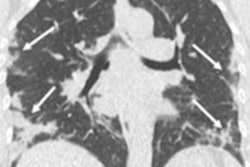
New details have emerged from the Middle East about the clinical features of COVID-19 that manifest on chest CT in patients who are severely ill. The information has come in a study published on 20 April in Radiology: Cardiothoracic Imaging, as well as a letter to the editor published on 17 April in Academic Radiology.
The two articles are some of the first to come out of Iran, which emerged as an early COVID-19 hotspot. As of 21 April, the country had more than 84,000 cases and more than 5,200 deaths, according to its Ministry of Health and Medical Education.
"Radiologists play a pivotal role in the era of COVID-19 pneumonia, although our knowledge of the imaging features is ... evolving," wrote a team led by Dr. Seyed Mohammad Hossein Tabatabaei of Shahid Beheshti Hospital in Kashan.
In their article in Radiology: Cardiothoracic Imaging, Tabatabaei and colleagues presented data from 120 symptomatic COVID-19 cases in patients who underwent chest CT, dividing them into three groups: Those who had routine hospital admission, those who were admitted to the intensive care unit (ICU), and those (in either hospital admission category) who died from the disease.
Of the 120 cases, 94% had ground-glass opacities on their CT scans, and the location of lesions tended to be peripheral and in lower lung zones. Patients initially admitted to the ICU and those who died of the disease had more consolidation, air bronchograms, crazy-paving patterns, and central involvement of the lungs compared with those who had routine hospital admission (p < 0.05).
"Our study supports previously described typical CT appearance of COVID-19 pneumonia," the group wrote. "Consolidation, air bronchograms, central lung involvement, and pleural effusion on initial CT chest have prognostic value, seen significantly more in ICU admitted and expired cases."
In related research published in Academic Radiology, another Iranian team advocated the use of chest CT to diagnose suspected COVID-19 if reverse transcription polymerase chain reaction (RT-PCR) testing is unavailable -- a position much under debate in recent literature.
"Several studies have demonstrated the higher sensitivity of CT than RT-PCR in detecting COVID-19 infected patients," wrote a group led by Dr. Alireza Radpour of the Iranian Society of Radiology in Tehran. "The high incidence of infected individuals in countries such as Iran, and the importance of pulmonary changes through the course of the disease, demonstrate that chest CT is superior to RT-PCR."
The team also described a low-dose, high-resolution CT protocol to protect patients from undue radiation exposure:
- Conduct the scan in one breath hold to reduce thoracic motion.
- Coronal and sagittal reconstructions are optional and maximum intensity projections are not required.
- Do not use oral or intravenous contrast.
- To minimize radiation dose, use the following parameters: 100 Kvp to120 Kvp, 50 mAs to 100 mAs, 0.8 to 1.5 pitch, and 1 mm to 3 mm slice thickness.
"Low-dose high-resolution CT might have more advantages than RT-PCR, especially in a highly infected society with low availability of PCR-kits," Radpour and colleagues concluded.



















